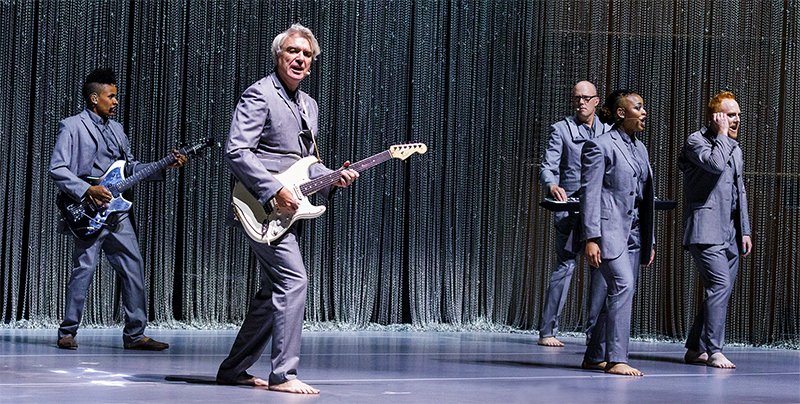As David Byrne enters his (inter)national treasure years, like Springsteen, Dylan and Young before him, it’s a rare treat to be able to see him in a concert hall setting, especially with an ambitious production like this which is tailor made for the arenas he’s got booked (no doubt with deluxe Blu-ray/coffee table book tie-in). New Wave’s silver fox/hipster uncle has really gone to town on this one.
That drive for quality extends to top-notch support act Laura Mvula – an unexpected bonus for those who arrive early. Barefoot, and dressed in what she describes as a “mermaid outfit with boxing shorts”, she stands at her keyboard side-on to the audience to deliver a complex set that deserves a gig of its own to truly appreciate. She reworks numbers like Sing To The Moon and Green Garden, set up by the drums and bass loops of multi-instrumentalist Troy Miller, whose opulent rack of gadgets seems wasted on a support slot. The focus is always on Mvula though, her intricate vocals and unpretentious audience chat – she seems genuinely stoked to be supporting Byrne – teeing up the night perfectly for what is to come…
This is gig-as-spectacle. Not for Byrne the conventions of four piece band, singer to the front, drummer to the back. His grey-suited twelve piece are marching band and theatre troupe. They turn a regular concert into a fringe musical and contemporary dance recital. To watch them, they’re the cast of Stomp practising tai-chi, they’re a firm of accountants playing wacky trust games on an away day, they’re a revivalist ministry descended on the neighbourhood to sing us into conversion.
Byrne, though the ringleader, places himself among this chorus line. He’s lead vocalist, but not frontman. These days he strikes the eye like a TED-talking professor. As often as not he delivers his song-sermons from the side or rear of the stage, while centre stage backing singers or percussionists draw the eye. Other times, he’ll be part of the throng as they parade around in formation. Each song has been individually choreographed as a mini-show in itself. For Here, with which he opens, he addresses a prop brain, “Alas, poor Yorick…” style. For Blind, a spotlight is dragged front and centre, turning the troupe into shadow dancers.
This group dynamic has its effect on the sound too. Byrne’s radio-miked vocals become inseparable from the morass of sound. On tracks like I Zimbra with its massed vocals, this is all well and good. On subtler tracks, clarity and some of Byrne’s words get lost. But any lack of crispness in the sound is made up for by the visual impact and the realisation that this wall of sound is being created from limited instrumentation, whilst the players are dancing. A brass sound emerges at one point and you can only conclude it’s a keyboard line as everyone else appears to be playing some variation of bongo/djembe drum.
The setlist explores all sorts of corners of Byrne’s career, including his St Vincent collaboration (I Should Watch TV), his guest appearance with Fatboy Slim’s Brighton Port Authority (Toe Jam) and mega-hit Lazy. He even squeezes in a cover of Janelle Monae’s protest song Hell You Talmbout as an encore.
But the biggest receptions are reserved for the Talking Heads numbers. Seeing Byrne doing his sleep-twitch dancing as that sparkly space noise introduces a stripped back, bass-heavy Once In A Lifetime makes your hairs stand on edge. No less primally charged are its Remain In Light counterparts, Born Under Punches and The Great Curve. Speaking In Tongues era is even better received. This Must Be The Place is a cue for people to start getting out of their seats. By the time a red-lit Burning Down The House closes the main set forty minutes or so later, no-one’s left sitting or in any mood to listen to Byrne try to say his goodbyes or thanks.
Although reliant on songs that are thirty-something for its best musical moments, this is the creation of a man engaged with the present and looking to the future. Even the way he foregrounds much younger players of diverse backgrounds seems to be a riposte to how some older white men might run the show. It’s not a rock gig as we know it. It’s David Bowie/Kate Bush-esque in its purloining of theatrical techniques. Would you want every gig to be like this? No. But would you watch it again and buy that Blu-ray? Oh yes.
